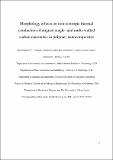Morphology effects on non-isotropic thermal conduction of aligned single- and multi-walled carbon nanotubes in polymer nanocomposites
Author(s)
Duong, Hai M.; Yamamoto, Namiko; Bui, Khoa; Papavassiliou, Dimitrios V.; Maruyama, Shigeo; Wardle, Brian L.; ... Show more Show less
DownloadJPCC Revision 040110 FINAL.pdf (1.147Mb)
PUBLISHER_POLICY
Publisher Policy
Article is made available in accordance with the publisher's policy and may be subject to US copyright law. Please refer to the publisher's site for terms of use.
Terms of use
Metadata
Show full item recordAbstract
Carbon nanotube (CNT)−CNT contact and CNT distribution effects on anisotropic thermal transport in aligned CNT−polymer nanocomposites (PNCs) are studied using an off-lattice Monte Carlo numerical simulation. Inter-CNT contact and the associated thermal boundary resistance are shown here to significantly affect transport properties of PNCs, including anisotropy ratios. Previous studies have considered the effective thermal conductivities of CNT−PNCs using only a very large CNT−CNT thermal boundary resistance (TBR) compared to that of the CNT−matrix TBR as a limiting case. As CNT−CNT TBR is currently an unquantified parameter for CNT−polymer systems, and because it may be reduced by various techniques, heat transport with CNTs in contact is studied for a wide range of CNT−CNT TBR values, varying from 2 to 25 × 10[superscript −8] m[superscript 2] K/W. The degree of CNT−CNT contact, CNT spatial distribution, and CNT−CNT TBR relative to CNT−matrix TBR are considered for 1−20% volume fraction of aligned single-walled and multi-walled CNTs. When CNT−CNT contact is significant or CNT−CNT TBR is low (relative to the CNT−matrix TBR), then heat transport is dominated by CNT−CNT contact effects, rather than CNT−matrix interfacial effects. As an example, effective nanocomposite thermal conductivity parallel to the CNT axis is shown to increase by up to 4× due to CNT−CNT contact effects. A critical value of CNT−CNT TBR is identified that controls whether the addition of conductive CNTs in the insulating polymer increases or decreases thermal transport. These simulation results can be very useful for developing techniques to enhance the effective thermal conductivity of composites using conductive nanomaterials embedded in (polymer) matrices, and assist experimentalists in interpreting heat conduction measurements.
Date issued
2010-04Department
Massachusetts Institute of Technology. Department of Aeronautics and AstronauticsJournal
Journal of Physical Chemistry C
Publisher
American Chemical Society (ACS)
Citation
Duong, Hai M. et al. “Morphology Effects on Nonisotropic Thermal Conduction of Aligned Single-Walled and Multi-Walled Carbon Nanotubes in Polymer Nanocomposites.” The Journal of Physical Chemistry C 114.19 (2010): 8851-8860.
Version: Author's final manuscript
ISSN
1932-7447
1932-7455